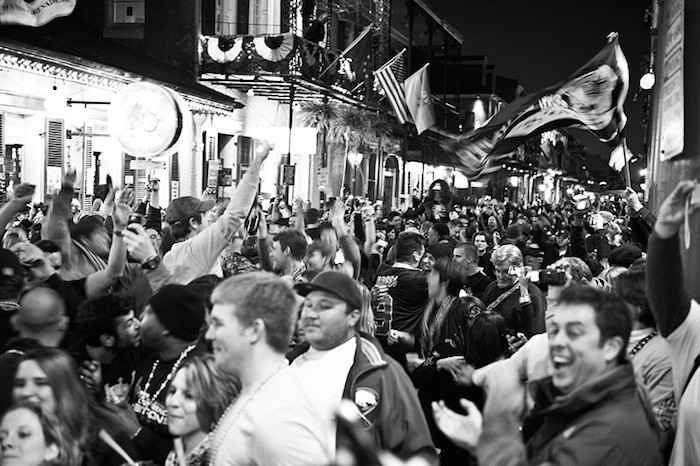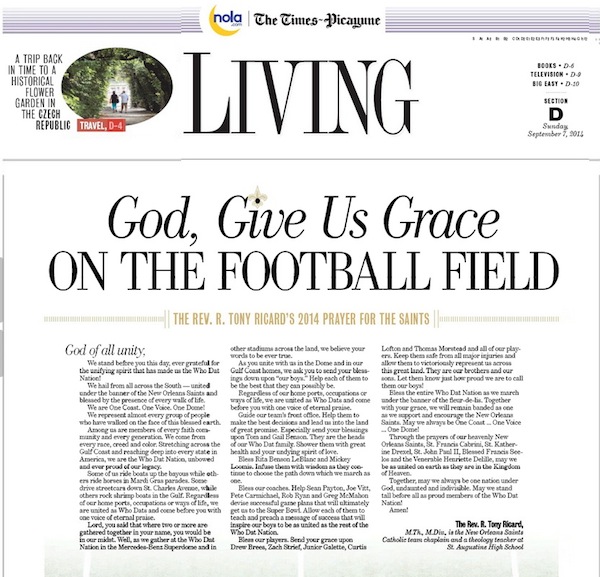
It’s probably not a happy morning in New Orleans. Despite leading 23-10 with less than four minutes left, a defensive breakdown and an incredibly poorly timed interception left the hometown Saints (my boss’ favorite team) with a stunning loss to the Detroit Lions (my favorite team).
But New Orleanians can at least commiserate with what look like normal editions of their largest daily newspaper, The Times-Picayune, delivered to their front doors.
The front page of today's edition of The Times-Picayune http://t.co/HBIrp5LKqL
— NOLA Media Group (@NOLAMediaGroup) October 20, 2014
While in most cities getting a Monday newspaper at your door isn’t a big deal, for readers in New Orleans it’s enough to give them whiplash. The Times-Picayune has continued to make changes to how it prints and distributes the newspaper since 2012 when Advance Publications, the paper’s parent, decided to only print papers three days per week and focus on producing digital content for its website, NOLA.com.
Last year, The Times-Picayune added new print products — a tabloid called TP Street and an early edition of the Sunday paper — that were sold only at newsstands on the four days a week that they weren’t previously printing a paper. But last month the paper scrapped the tabloid and went back to a full broadsheet paper seven days a week — though still with only a partial home delivery schedule.Readers who subscribe to The Times-Picayune will now have copies of the paper delivered to their homes on Saturdays and Mondays through the end of the Saints’ season in addition to the normal delivery days of Wednesday, Friday, and Sunday. There will also be home-delivered papers on Thanksgiving and Christmas Day.
In announcing the move, the paper wrote that it was changing to a broadsheet because its what readers prefer and adding additional home delivery days because “our readers’ interest peaks in the fall and so does our advertisers’ desire to reach them.” In an interview, Times-Picayune editor Jim Amoss told me reader demand was the main reason for the change in home delivery days.
“My take on it was that it was based on reader demand and that advertisers would welcome it, especially on Saturday,” Amoss said. “I don’t think anyone has any illusions about the demand for Monday newspapers in the United States — even on hot Mondays after the Saints game, it’s never going to be one of the big advertising days. But I think the impetus was readers telling us in no uncertain terms that they would really like to especially read about Saints and LSU coverage and have it home delivered to their doorsteps on days after games.”
Many outside observers see The Times-Picayune reacting to a challenge from The Advocate, an outgrowth of the Baton Rouge paper, that launched after The Times-Picayune reduced its print schedule. The Advocate hired many longtime Times-Picayune staffers, and has also emphasized coverage of the Saints along with coverage of LSU football.
“I think that if the Advocate wasn’t there they wouldn’t be doing this,” said Michael Giusti, a journalism professor at Loyola University New Orleans. “Obviously the unique variable is that a daily paper came in from Baton Rouge and put a little more leverage on them than they were really comfortable with.” For his part, Amoss downplayed the competition with the Advocate, and instead emphasized that The Times-Picayune is primarily focused on “digital competition” — from local TV station websites and other local and national online outlets. “Those are the forces that we, like other metro newspapers have to contend with,” he said.
Louisianians certainly love their football, and this isn’t the first time The Times-Picayune has offered a print product with Saints fans in mind. In 2012, after slashing print days, the paper printed and delivered a tabloid with only Saints and NFL coverage the Monday after every game. (This time around, the extra papers are full editions of the paper, not just focused on sports.)
And since the switch to a web-first mentality in 2012, there’s been an increase in the amount of sports and entertainment coverage published in print, online, and on mobile apps, according to a content analysis comparing articles from October 2011 and October 2013 by Tulane professor Vicki Mayer and her students that was published in a new book that she co-authored, The Times-Picayune in a Changing Media World: The Transformation of an American Newspaper.
Over half of the 2011 print stories were in the following areas: politics, education, business and environment. These beats collectively fell to about one-third of the stories in print and mobile phone editions, and even lower on the Internet and iPad homepages in 2013. Only one in five stories on the web homepage and one in ten on the iPad fit these important news beats. Conversely the proportion of crime stories nearly doubled on the phone app and the website, from 18 percent of print stories to 30 percent and 33 percent respectively. A whopping 83 percent of iPad homepage stories were focused on either sports or entertainment.
Amoss dismissed the study’s findings earlier this year, telling the Columbia Journalism Review that the study was flawed because Mayer and her team didn’t monitor NOLA.com over a 24-hour period, instead checking the homepage at various points throughout the day.
But the operation’s emphasis on football is still evident in how The Times-Picayune approaches its coverage now. “Our team of 165 journalists, including 40 reporters and columnists covering Saints, LSU, Tulane, other college football and high school football, is unmatched in the state,” The Times-Picayune’s August post announcing the latest changes bragged — a remarkable share of resources dedicated to the sport. (Many of those who cover high school football for the paper are freelancers, not full-time staffers, Amoss said.)
And the coverage extends beyond even the sports section. The lead story in The Times-Picayune’s Sunday Living section the day before the new Monday edition launched was a prayer for the Saints in advance of their new season written by the team’s Catholic chaplain. Online, NOLA.com, posted video of the chaplain reading the prayer from the field of the Superdome, the Saints’ home stadium.

“Bless the entire Who Dat Nation as we march under the banner of the Fleur-de-Lis,” Rev. R. Tony Ricard said. “Together with your grace, we will remain banded as one as we support and encourage the New Orleans Saints.” Today, they — like the newspaper business — could use the help.